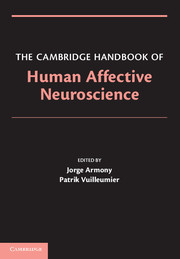Book contents
- The Cambridge Handbook of Human Affective Neuroscience
- The Cambridge Handbook of Human Affective Neuroscience
- Copyright page
- Dedication
- Contents
- List of Contributors
- Introduction
- Section I Introduction to Human Affective Neuroscience
- Section II Measuring Emotional Responses
- Section III Emotion Perception and Elicitation
- Chapter 7 The Facial Expression of Emotions
- Chapter 8 Bodily Expressions of Emotion
- Chapter 9 Pain and the Emotional Responses to Noxious Stimuli
- Chapter 10 Examining Emotion Perception and Elicitation via Olfaction
- Chapter 11 Emotional Voices
- Chapter 12 Emotion and Music
- CHAPTER 13 Love Letters and Hate Mail
- Section IV Cognitive-Emotion Interactions
- Section V Emotional Learning and Memory
- Section VI Social Emotions
- Section VII Individual Differences in Emotion
- Index
CHAPTER 13 - Love Letters and Hate Mail
CerebralProcessing of Emotional Language Content
from Section III - Emotion Perception and Elicitation
Published online by Cambridge University Press: 05 February 2013
- The Cambridge Handbook of Human Affective Neuroscience
- The Cambridge Handbook of Human Affective Neuroscience
- Copyright page
- Dedication
- Contents
- List of Contributors
- Introduction
- Section I Introduction to Human Affective Neuroscience
- Section II Measuring Emotional Responses
- Section III Emotion Perception and Elicitation
- Chapter 7 The Facial Expression of Emotions
- Chapter 8 Bodily Expressions of Emotion
- Chapter 9 Pain and the Emotional Responses to Noxious Stimuli
- Chapter 10 Examining Emotion Perception and Elicitation via Olfaction
- Chapter 11 Emotional Voices
- Chapter 12 Emotion and Music
- CHAPTER 13 Love Letters and Hate Mail
- Section IV Cognitive-Emotion Interactions
- Section V Emotional Learning and Memory
- Section VI Social Emotions
- Section VII Individual Differences in Emotion
- Index
Summary
Keywords
- Type
- Chapter
- Information
- The Cambridge Handbook of Human Affective Neuroscience , pp. 304 - 329Publisher: Cambridge University PressPrint publication year: 2013
- 10
- Cited by

